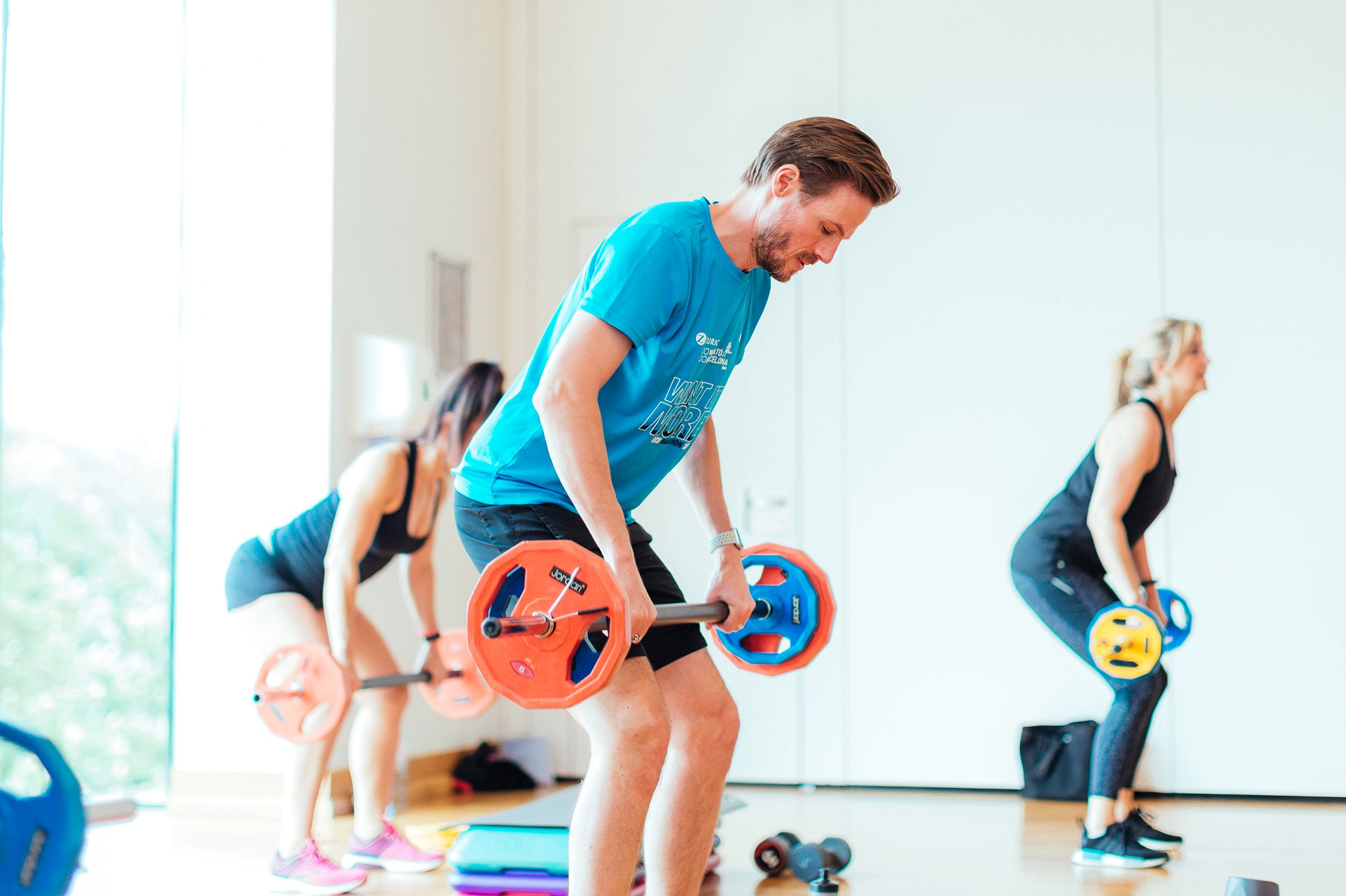

Featured
What Are Circuits Workout
Modified: August 21, 2023
Get ready for an intense full-body workout with our featured circuits workout. Burn calories, build strength and improve endurance in this dynamic training session.
Introduction
Welcome to the world of circuit workouts! If you’re looking for a dynamic and efficient way to amp up your fitness routine, circuit workouts may be just what you need. Whether you’re a beginner or a seasoned fitness enthusiast, circuit training can offer a multitude of benefits and help you achieve your fitness goals.
Circuit workouts have gained popularity in recent years due to their versatility and effectiveness. By combining strength training exercises with cardiovascular activities, these workouts provide a full-body challenge that can boost your endurance, build lean muscle, and burn calories.
Unlike traditional workout routines that focus on specific muscle groups or exercises, circuit workouts involve performing a series of exercises consecutively with minimal rest in between. This fast-paced, high-intensity format keeps your heart rate elevated, maximizing the benefits of both strength training and cardiovascular exercise.
Whether you prefer to work out at the gym, in the comfort of your own home, or even outdoors, circuit training can be adapted to fit your needs and equipment availability. You can use a combination of bodyweight exercises, dumbbells, resistance bands, or even household items to create a challenging and effective circuit workout.
In this article, we’ll explore the concept of circuit workouts in more detail, discuss their benefits, and provide some tips and examples to help you design your own circuit routine. So, get ready to get your heart pumping and your muscles working as we dive into the world of circuit training!
What Are Circuit Workouts?
Circuit workouts, also known as circuit training, are a form of exercise that combines strength training exercises with cardiovascular activities in a structured and systematic manner. Instead of focusing on a single exercise or muscle group, circuit workouts involve performing a sequence of exercises in a circuit format.
The circuit format typically consists of a series of exercises performed back-to-back, with minimal rest periods in between. Each exercise is performed for a set amount of time or a predetermined number of repetitions before moving on to the next exercise in the circuit. Once all exercises in the circuit are completed, a short rest period is taken, and the circuit is repeated for a certain number of rounds.
One of the primary goals of circuit workouts is to keep the heart rate elevated throughout the entire session, providing a cardiovascular stimulus while also targeting various muscle groups. By incorporating both strength training and cardiovascular exercises, circuit workouts offer a balanced and efficient way to improve overall fitness.
Circuit workouts can be customized to suit individual fitness levels and goals. They can range from beginner-friendly routines that focus on basic exercises and lower intensity, to advanced workouts that incorporate complex movements and higher intensity levels.
Furthermore, circuit workouts can be designed to target specific fitness components, such as muscular strength, muscular endurance, or cardiovascular fitness. The exercises within the circuit can be selected based on the desired goals and can be modified as needed to accommodate individual preferences and limitations.
Overall, circuit workouts provide a time-efficient and effective way to maximize your workout in a limited amount of time. They offer a combination of cardiovascular benefits, muscle toning, and calorie burning, making them a popular choice for individuals looking to optimize their fitness routine.
Benefits of Circuit Workouts
Circuit workouts offer a multitude of benefits that make them a popular choice for individuals seeking an efficient and effective fitness routine. Let’s explore some of the key advantages of incorporating circuit training into your workout regimen:
- Time Efficiency: In today’s fast-paced world, time is often a constraint when it comes to fitness. Circuit workouts are designed to maximize efficiency by combining strength training exercises with cardiovascular activities, allowing you to get a full-body workout in a shorter period of time compared to traditional exercise routines.
- Increased Calorie Burn: Due to the high-intensity nature of circuit workouts, they can help you burn a significant number of calories in a shorter amount of time. The combination of strength training and cardiovascular exercises elevates your heart rate, resulting in a higher calorie expenditure both during and after the workout.
- Improved Cardiovascular Fitness: Circuit training keeps your heart rate elevated throughout the entire session, providing an effective cardiovascular workout. Over time, this can lead to improved heart and lung function, increased endurance, and better overall cardiovascular health.
- Enhanced Muscle Strength and Endurance: The inclusion of strength training exercises in circuit workouts helps to build and tone muscles. By challenging different muscle groups in a continuous and varied manner, circuit training can lead to increased muscle strength and endurance.
- Versatility and Adaptability: Circuit workouts can be tailored to suit individual fitness levels, goals, and equipment availability. Whether you prefer bodyweight exercises, resistance bands, or gym equipment, circuit training can be customized to match your preferences and fitness needs.
- Variety and Motivation: The dynamic and varied nature of circuit workouts helps to keep you engaged and motivated. With a wide range of exercises and the ability to constantly modify and switch up the routine, circuit training prevents boredom and makes your workouts more enjoyable.
With these numerous benefits, it’s no wonder that circuit workouts have become a popular choice for individuals looking to maximize their fitness results in a time-efficient manner. Whether your goal is to lose weight, build muscle, or improve overall fitness, incorporating circuit training into your routine can help you achieve success.
How to Design a Circuit Workout
Designing a circuit workout involves careful consideration of various factors, including your fitness goals, available equipment, and personal preferences. Here are the steps to create an effective circuit routine:
- Identify your goals: Determine what you want to achieve with your circuit training. Whether it’s building strength, increasing endurance, or losing weight, clarifying your goals will help you select the appropriate exercises for your circuit.
- Select your exercises: Choose a variety of exercises that target different muscle groups and provide a balance between strength training and cardiovascular exercises. Include compound movements like squats, lunges, push-ups, and planks, along with exercises that elevate your heart rate such as jumping jacks, burpees, or mountain climbers.
- Determine the number of rounds: Decide how many rounds you will perform in your circuit. Beginners may start with 2-3 rounds, while more advanced individuals can aim for 4-5 rounds.
- Set the work and rest intervals: Determine the amount of time you will spend on each exercise and the rest periods in between. For example, you can perform each exercise for 30-60 seconds and rest for 10-15 seconds before moving on to the next exercise.
- Arrange the exercises: Arrange the exercises in a logical sequence, considering alternating between upper and lower body movements or between different muscle groups. This will ensure a balanced and effective workout.
- Warm up and cool down: Don’t forget to incorporate a proper warm-up before starting your circuit and a cool-down at the end. This could include dynamic stretches, light cardio, or mobility exercises to prepare your body for the workout and aid in recovery.
- Track your progress: Keep a record of your circuit workouts to track your progress and make adjustments as needed. Monitor the number of repetitions or the amount of weight used for each exercise, and gradually increase the difficulty as your fitness improves.
Remember, it’s essential to listen to your body and choose exercises that align with your fitness level. Don’t be afraid to modify exercises or take breaks if needed. The most important thing is to maintain proper form, challenge yourself, and have fun throughout your circuit training sessions.
Example Circuit Workout
To give you a better understanding of how a circuit workout is structured, here’s an example circuit routine that can be done with minimal equipment:
- Jumping Jacks: Perform jumping jacks for 60 seconds, focusing on a steady pace and full range of motion.
- Push-Ups: Move to push-ups for 45 seconds, maintaining proper form and engaging your core and chest muscles.
- Bodyweight Squats: Transition into bodyweight squats for 60 seconds, focusing on proper squatting technique and engaging your glutes and quadriceps.
- Mountain Climbers: Move on to mountain climbers for 45 seconds, combining core stability and cardiovascular exercise.
- Lunges: Perform walking lunges for 60 seconds, alternating legs with each step and keeping your upper body straight.
- Plank: Finish the circuit with a plank exercise for 45 seconds, maintaining a straight line from your head to your heels and engaging your core.
After completing all the exercises, take a 15-second rest, and then repeat the circuit for 3-4 rounds. Remember to adjust the work and rest intervals based on your fitness level and gradually increase the duration or intensity as you progress.
This example circuit workout targets multiple muscle groups, combines cardiovascular and strength exercises, and can be completed in a relatively short period of time. Feel free to modify or substitute exercises based on your preferences and equipment availability.
Always prioritize proper form and technique during each exercise to maximize the effectiveness of the workout and minimize the risk of injury. And don’t forget to include a warm-up and cool-down to prepare your body for the circuit and facilitate recovery.
Remember, this is just one example, and the beauty of circuit workouts is their versatility. Feel free to get creative and design your circuit routines by incorporating different exercises, equipment, and variations to keep your workouts challenging and enjoyable.
Tips for Effective Circuit Training
To get the most out of your circuit training sessions, consider the following tips to enhance your effectiveness and overall experience:
- Focus on proper form: Maintaining proper form during each exercise is crucial for maximizing results and reducing the risk of injury. Take the time to learn and practice correct technique for each movement in your circuit.
- Gradually increase intensity: As your fitness level improves, aim to increase the intensity of your circuit workouts. This can be achieved by adding weights, increasing repetitions, or shortening rest periods to keep pushing yourself.
- Include a variety of exercises: Keep your circuit workouts fresh and engaging by incorporating a variety of exercises that target different muscle groups. This will prevent boredom and ensure a well-rounded workout.
- Listen to your body: Pay attention to how your body feels during the workout. If something doesn’t feel right or causes pain, modify or skip the exercise. It’s important to prioritize your safety and well-being.
- Take adequate rest: While minimal rest periods are a characteristic of circuit training, it’s essential to allow yourself enough time to recover between circuits. Proper rest ensures that your muscles can perform optimally during each round.
- Stay hydrated: Hydration is important during any exercise routine, so make sure to drink plenty of water before, during, and after your circuit workouts to replenish fluids lost through sweat.
- Combine resistance and cardiovascular exercises: The combination of strength training and cardio exercises in circuit workouts provides a well-rounded workout. Incorporate exercises that challenge different muscle groups and elevate your heart rate.
- Set realistic goals: Be realistic about your fitness level and goals when designing your circuit workouts. Gradually increase the difficulty as you progress, but always prioritize safety and proper form.
- Track your progress: Keep a record of your circuit workouts, including the exercises, repetitions, and weights used. This will help you monitor your progress, identify areas of improvement, and stay motivated.
- Enjoy the process: Circuit training can be challenging, but it’s important to enjoy the process and have fun. Find exercises and variations that you enjoy, and mix up your workouts to keep them exciting.
By incorporating these tips into your circuit training routine, you can enhance the effectiveness of your workouts and continue to progress towards your fitness goals. Remember that consistency and dedication are key to achieving long-term results.
Common Mistakes to Avoid in Circuit Workouts
While circuit training is a highly effective fitness approach, it’s important to be mindful of common mistakes that can hinder progress and increase the risk of injury. Avoiding these mistakes will help you make the most out of your circuit workouts. Here are some common mistakes to be aware of:
- Improper form: One of the most common mistakes in circuit training is sacrificing proper form for speed or intensity. It’s essential to prioritize quality over quantity. Focus on maintaining correct form during each exercise to maximize effectiveness and minimize the risk of injury.
- Skipping warm-up and cool-down: Neglecting to warm up before a circuit workout can increase the risk of muscle strains and injuries. Likewise, failing to cool down afterwards can lead to muscle soreness and stiffness. Always include a proper warm-up and cool-down to prepare your body for the workout and aid in recovery.
- Overtraining: It’s important to give your body adequate time to rest and recover. While the intensity of circuit workouts is high, remember to schedule rest days in between sessions to allow your muscles to repair and grow.
- Ignoring modifications: Every individual is different, and it’s important to modify exercises to suit your fitness level and any limitations you may have. Failing to make necessary modifications can lead to injury or excessive strain on your body.
- Not incorporating progression: To continue seeing improvements in your fitness, it’s important to gradually progress your circuit workouts. This can be done by increasing weights, repetitions, or intensity over time. Sticking to the same routine without challenging yourself can lead to plateauing results.
- Excessive cardio focus: While cardiovascular exercises are beneficial, it’s essential to include strength training exercises in your circuit as well. Neglecting strength training can hinder muscle development and overall fitness improvements.
- Ignoring rest periods: Rest periods are crucial in allowing your muscles to recover and regenerate energy. Avoid the temptation to skip or shorten rest periods. Properly timing your rest periods will maintain the integrity of your workouts and prevent fatigue-related issues.
- Not listening to your body: Pay attention to your body’s signals and pace yourself accordingly. Pushing beyond your limits or ignoring discomfort can lead to injuries and burnout. Give yourself permission to rest or modify exercises as needed.
- Not seeking professional guidance: If you’re new to circuit training or have specific fitness goals or concerns, consider consulting with a fitness professional to ensure you’re using proper form, targeting the right exercises, and progressing safely.
- Forgetting to hydrate: Adequate hydration is key for optimal performance and recovery. Make sure to drink water before, during, and after your circuit workouts to prevent dehydration.
By being aware of these common mistakes and taking steps to avoid them, you can ensure that your circuit workouts are safe, effective, and yield the desired fitness results.
Conclusion
Circuit workouts offer a dynamic and efficient way to improve your overall fitness. By combining strength training exercises with cardiovascular activities, circuit training provides a full-body challenge that can help you build strength, increase endurance, and burn calories. Whether you’re a beginner or a fitness enthusiast, circuit training can be customized to suit your needs and goals.
In this article, we explored what circuit workouts are and discussed their numerous benefits, including time efficiency, increased calorie burn, improved cardiovascular fitness, enhanced muscle strength and endurance, and versatility. We also provided tips on how to design an effective circuit routine and offered an example circuit workout to get you started.
However, it’s important to avoid common mistakes in circuit training, such as improper form, skipping warm-up and cool-down, overtraining, ignoring modifications, and not incorporating progression. By being mindful of these mistakes, you can maximize the effectiveness of your workouts and reduce the risk of injury.
Remember, circuit training should be enjoyable and adaptable to your fitness level and preferences. Don’t hesitate to customize your workouts, experiment with different exercises and variations, and track your progress to stay motivated and see continuous improvements.
So, whether you’re looking to spice up your fitness routine, save time, or challenge yourself in new ways, circuit training can be a valuable addition to your workout regimen. Give it a try and experience the benefits of this dynamic and effective training method. Get ready to elevate your fitness to new heights with circuit workouts!








